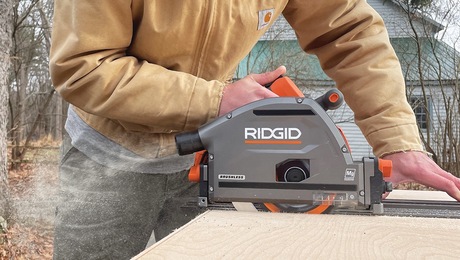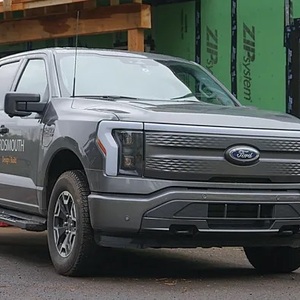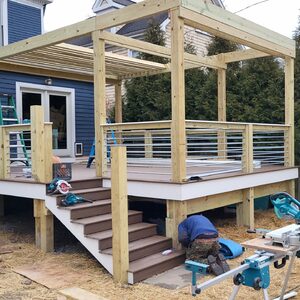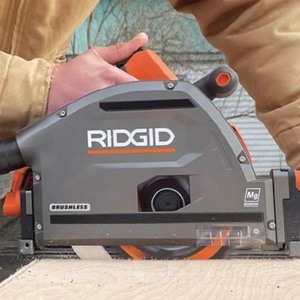200 amp disconnect from small panel?
We’re building a new home in Vermont. The first step will be to construct a small barn. The meter socket will permanently be installed on this structure. From here I will run to the house when the house is ready. Service is 200 amps. I would like to bring all 200 amps to the house. The panel in the barn should be as small as possible; I won’t need many slots. Unlitmately, I would like one or two 20 amp circuits in the barn for lighting and tools, maybe a 20 amp 230 circuit for the bandsaw and a circuit for a future welder or something. So, 4 slots is plenty. Could I have some help identifying the parts I’ll need. Does such a small panel exist that could accomodate a 200 amp disconnect for the house? Would I have a separate disconnect box next to the small panel? Once in the house I’ll want a 40 slot panel in the basement, and a 50 amp subpanel upstairs somewhere.


















Replies
SUch panells exist. I don't have any any specific part numbers.
But my neighbors did some remodeling and upgraded their service to 200 amps. They have an GE external pannel with a 200 amp disconnect. In their case it the just feed off the 200 amps off the bus to the inside panel.
But there are about 8 slots (I am guessing. In a house those are often used to feed nearby AC's or a subpanel.
In your case they would be used to feed the barn circuits (or a barn subpanel).
There would be no disconnect at the barn for the house. But none is needed.
At the house you would either install a 200 amp disconnect or use the "main" panel as the disconnect.
I say "main" panel as the best option (and required if there are anyother metallic paths such as phone cable or metallic water pipes) is a 4 wire connection and the house panel is wired as a sub-panel.
In any case ground electrodes are required at both the barn and house.
.
A-holes. Hey every group has to have one. And I have been elected to be the one. I should make that my tagline.
Consider a 200A simple disconnect with separate control center boxes in the barn and house
Be sure that the control centers are wired as sub-panels with floating neutrals
(If you're now saying "Huh?" -- or even, "I've heard of that" -- consider hiring an electrician)
With my mouth I will give great thanks to the Lord; I will praise Him in the midst of the throng. For He stands at the right hand of the needy, to save them from those who would condemn them to death.
- Psalms 109:30-31
So I go from the socket to a disconnect. Do I split here to two 200 amp panels, one in barn and one in house? Or is there a product available that lets me have a 50 amp breaker with a line to the barn subpanel and a 200 amp breaker with a line to the house?
You would have a big 200 amp breaker in your main exterior barn panel that would feed the subpanel on the house. You would have another 50 amp breaker right next to it feeding the subpanel inside your barn. This is besides the 200 amp main disconnect breaker, which will look identical to the other 200 amp breaker.
This is a little hard to think out - you will have a total of 450 amps of breakers (200 + 200 + 50) in that main panel. One of those 200 amps feeds the power into the breaker bus from the power companies feeder lines (from the meter, in other words). Trip this and power goes out to your house and barn. From the breaker bus, power gets fed down the 50 amp line to the barn subpanel and the 200 amp line to the house subpanel.Rebuilding my home in Cypress, CA
Also a CRX fanatic!
I just found this.... http://www.geindustrial.com/publibrary/checkout/38652.30055.15471.2973/generic/DET427A%20TSMR%20Fact%20Sheet.pdf ...would this do the job cleanly?
Edit - 450 amps in 200 amp panel is not hard to understand. I must have at least 650 amps of breakers in my 200 amp panel now!
Edited 3/30/2007 1:19 pm ET by tuolumne
That will work, but not as described.The 200 amp breaker takes 4 (equavilant to a 4 pole breaker) spaces and that it all that would fit in it.You can get larger panels though.But the you really don't need to.There is no need or reason for a breaker on the feed to the house. It is already overload protected by the 200 amp main breaker. Now if you wanted a feed that was smaller then it would need to be protected by a smaller breaker.And the panel has lugs on the hot busses to feed the sub-panel at full rated current.http://www.gecatalogs.com/content/offline/buylog/01_BL.pdf Page 5 for the 200 amp breakers).Ignore the prices shown. I think that they are about 4-5 times sales price.But you still don't want to pay for a 200 amp breaker unless you need one..
.
A-holes. Hey every group has to have one. And I have been elected to be the one. I should make that my tagline.
Thanks for that catalog...very helpful. Yes, I see I could pass the 200 amp through to the main panel breaker in the house. Would there be any reason to put a 50 amp panel in the garage, or could I just use the meter/main panel outside for the individual barn circuits? A six slot panel would be about right...double 230V 30 amp for welder or such, double 230V 15 amp for power tools, single 15 amp lighting circuit, and single 20 amp circuit for outlets. I'd probably put an outlet on that 15 amp circuit to split up demand during construction. If I'm using both bottom holes (service in and service out to the house) where does my wiring from the barn exit? Can it go straight through the back into the barn?
There are probably places all over the panel (or a hole punch could add more) for either a feed out the back or out the bottom or side and then a conduit body (elbow) to feed it into the barn.If that is all the circuit then you could get by with using that panel and no sub-panel.But I would run a 60 amp feed into the barn and use a 100 amp sub-panel. The reason for the 100 amp is that they are common and cheap and you get them with 12 or so slots. Never know when you might want to stuff in an electric heater or run a couple of other circuits.Of course you can always do that latter if needed.Except for lighting you want your 120 and 240 circuits to be 20 amp (or more for things like the welder). Don't bother with 15 amp circuits..
.
A-holes. Hey every group has to have one. And I have been elected to be the one. I should make that my tagline.
A six slot panel would be about right...double 230V 30 amp for welder or such, double 230V 15 amp for power tools, single 15 amp lighting circuit, and single 20 amp circuit for outlets.
Big mistake using that tiny panel.
I don't see a compressor on your list of tools, if it's a shop sooner or later you will want a compressor.
When the compressor tries to start whatever else is running is going to be starved for power, then what?
What about dust collection? Don't see it on the list? What else isn't there? Need heat? Refrigerator to keep the beer cold?
Joe H
Or if he's English, a beer heater.Rebuilding my home in Cypress, CA
Also a CRX fanatic!
I should have called this a shed, not a barn. The real barn will be later. The shop is in the basement off the 200 amp panel there.
The all in one panel is what I was looking for. I found one with 12 slots that should meet all needs, with lugs for 200 amp pass through.
I was mistaken about the one I suggested before. It was a Homeline box not a QO box.
The one you've found is a better box. But as suggested before, it only has a limited number of spaces so you have to be sure its enough to meet your needs.
Square D makes a nice sized 200 amp panel that would be perfect for your barn. It can accomodate 8 circuits using the QO mini breakers or 4 circuits using regular sized breakers.
I believe it runs about $175. It has lugs to feed through to the house and enough breaker space to satisfy your barn.
I don't have the catalog here, but you could easily find it.
I think you're making more of this then you need to.
First of all, many folks are a bit confused about what, say, makes a 200 amp panel a 200 amp panel. The short answer is ... it is protected by a 200 amp breaker, and has lugs big enough for 200 amp wire.
Now, that "protection' can be in three different places. It can be where the panel is fed from; it can be in the panel itself, or it can be in a fused disconnect somewhere in-between.
Out west, we often use "All-in-one" load centers. These have the meter base, disconnect, and panel- all in the same box. "Back East," the three are often separate items.
As a separate building, you are almost sure to need a disconnect on the outside of the building. You will need a ground rod. And, if by "barn" you mean a place where animals are kept, the NEC might have some special grounding requirements as well.
If both the house and the barn will have their own meter, they are likely to be considered 'separate services,' and some different rules will likely apply.
Let me describe what a typical approach to this situation would be.
The house would have the "main" panel, or "main" disconnect. At that point I would use a breaker to feed the barn, sized to match the actual expected load. I would run as large a pipe as I could from that panel, out to a disconnect on the outside of the barn. I'd bury that pipe at least 2 ft. deep (This really means a 30" ditch!). I'd size the disconnect for 200 amps, and connect it to the panel inside, again with the largest pipe I can fit. This inside panel I would 'size' by the number of breaker spaces I expect to need.
Now, let's assume that you start out only needing 60 amps out at the barn, but later need, say, 120 amps. You've run large pipe, so you can pull out the little wires, and replace them with big ones. You replace the 60 amp breaker with a larger one. At that point, changing the panel for a larger-rated one is not a big deal, but will probably not be necessary.
One thing to keep in mind is that "panel size" has absolutely nothing to do with the number of breakers that will fit into it.
" As a separate building, you are almost sure to need a disconnect on the outside of the building. "Again that is a local/regional difference.The NEC allows the disconnect on the inside, "near" where it enters the building..
.
A-holes. Hey every group has to have one. And I have been elected to be the one. I should make that my tagline.
are you sure you can get 200 amp? BIL built his house in VT he was too far from the road and could only get 150 amps unless he went to some expense.
bobl Volo, non valeo
Baloney detecter WFR
"But when you're a kibbutzer and have no responsibility to decide the facts and apply the law, you can reach any conclusion you want because it doesn't matter." SHG
Yep, the power company allows up to 3% voltage drop from pole to meter which gives me about 300 feet for the 200 amp service. If I want to go further the costs would be for upgrading cable size or adding a transformer.
Personally, I would use a meter pedestal outside and the 200 amp panel inside. This keeps your circuit breakers inside the building.
Don't forget to add on the distance from the barn to the house when you are figuring on your line length and voltage drop.
Square D makes a combo meter/panel it has 8 slot with feed through lugs for when you connect your house.
So I heard. Do you have a link to one? Does this lock me into a certain style of breaker? I'm not familiar with the local supplie places, so I'm not sure what will be the easiest to find. Around here GE seems pretty common.
Yep. Put in a Square D panel, you'll have to use Square D breakers.George Patterson, Patterson Handyman Service